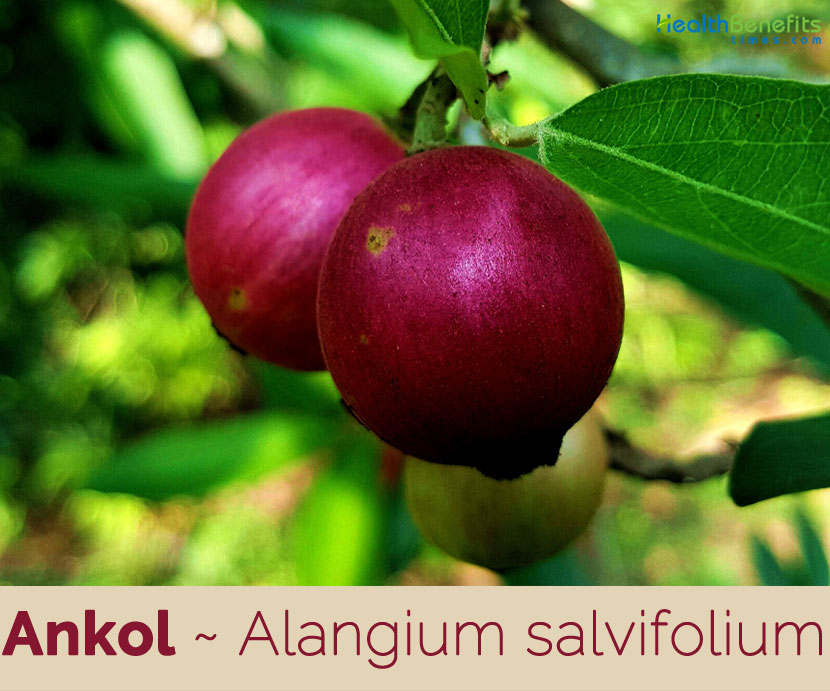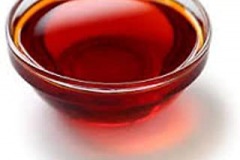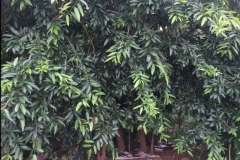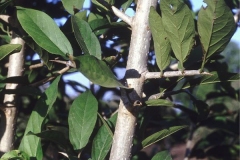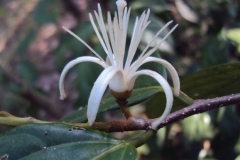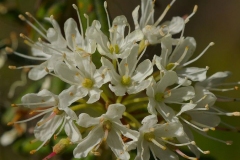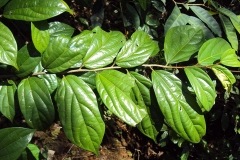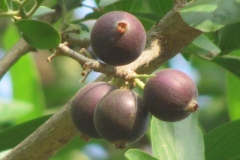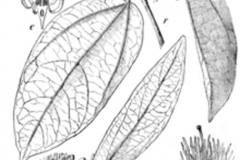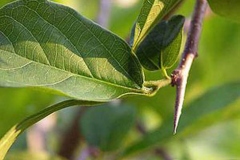Ankol tree is found throughout drier parts of India. It is a medicinal tree and its various parts are used in Ayurveda and Siddha system of medicine for the treatment of diseases. In Ayurveda, Ankol is the single medicinal herb that is used in the treatment of rabies. For this purpose the root bark is used both externally and internally. It is also used in the treatment of snake bite. Ankol tree is also used for the treatment of diarrhea, abdominal pain, ascites, skin diseases and fever. All the parts root, bark, leaves, seeds and fruits possessed considerable therapeutic uses. These compounds belong to the natural products called flavonoids, glycosides, alkaloids and saponin. During the last three decades, apart from the chemistry of the alangiium compounds, considerable progress has been achieved regarding the medicinal applications and biological activity of alangium. It is considered as a valuable source of natural products for development of medicines against various diseases.
Ankol Facts
| Ankol Quick Facts | |
|---|---|
| Name: | Ankol |
| Scientific Name: | Alangium salvifolium |
| Origin | Western Africa, Madagascar, Southern and Eastern Asia, tropical Australia |
| Colors | Green turning to purplish to red to black as they mature |
| Shapes | Ovoid, ellipsoid or nearly globose berries about 1.3 - 1.6 cm long, glabrous, smooth |
| Taste | Bitter, astringent, pungent |
| Health benefits | Beneficial for rheumatism, hemorrhoid, Arthritis, Herpes, osteoarthritis, premature ejaculation, piles, hypertension, diarrhea, asthma, fever, back pain, blood disorders, leprosy, scabies and acute joint pain. |
| Name | Ankol |
|---|---|
| Scientific Name | Alangium salvifolium |
| Native | Western Africa, Madagascar, Southern and Eastern Asia (China, Malaysia, Indonesia, India, and Philippines), tropical Australia, the western Pacific Ocean islands and New Caledonia. |
| Common Names | Sage leaved alangium, sage leaves, Ankol |
| Name in Other Languages | Arabic: Ealanaj qaseayni al’awraq ( علنج قصعيني الأوراق) Bengali: Akarkanta (আকরকাঁটা), Baghankura, Aankod, Badh Aankod Cambodia: Ang kol, khou khao Chinese: Ān kòu lā (安寇拉) German: Ankola Greek: Ankola Gujarati: Ankol, Onkla Hindi: Ankol (अकोल), dera, dela, angol, ankora, Dhera, akola, ankera, dhela, ghaul, akhaul, akol, anedhera, ankora, kweli, thailaankul, akola, akolah, dirghakila (दीर्घकील), nedishth (नेदिष्ठ), pita-sara (पीतसार), tamraphala (ताम्रफल) Indonesia: Wait sesatak Japanese: Ankora (-アンコラ) Kannada: Ankole (ಅಂಕೋಲೆ), ankole, ankole mara, ankota, ankotha, anroli, ansroli, asroli, guddada doani, guddaga goni (ಗುಡ್ಡದ ಗೋಣೀ), kallu maavina mara (ಕಲ್ಲು ಮಾವಿನ ಮರ), kallu maavu, kallu-maavu, kare ankole gida, lucki, ankalige, ankili, ankoelaemara, ankolare, ankoleda, ankolo, ankolu, anosroli, guddadagoni, kallumavina, kallumavu, amkole Laos: Khou khao, ‘phou khao Malayalam: Ankolam, Velittanti, azhinni, alinnil, angolam, kara-angolam, velittondi, alanci, alangi, arinil, arinjil, cem, chem, chemmaram, karaangolam, karangolam, karankolam, kimri, vallithondi, vlittonti, vvallittonti, amkolam-chettu, ayan-golam, aṅkēālaṁ(അങ്കോലം), ankolam, karankolam (കരങ്കോലം), valli ankolam (വള്ളി അങ്കോലം) Marathi: Ankul (अंकुल), akel, akola, ankol, ankoli, ankool, amgolum, amkolam Nepali: Amphee (अंफी), Ankol (अंकोल), Ēkōlā (एकोला) Oriya: Bagha ankura (ବାଘ ଆଙ୍କୁଡ଼ା), morata (ମୋରଟ) , ankota (ଅଙ୍କୋଟ), lamba karnna (ଲମ୍ବ କର୍ଣ୍ଣ), pita sara (ପୀତ ସାର) Pali: Ankol (अंकोल) Persian: -قورباغه Philippines: Guntapai Punjabi: Akola (ਅੰਕੋਲ) Sanskrit: Ankodah, ankola, ankolah, ankolla, ankollakah, ankota, ankotah, dheergha, dirghakila, dirghakilaka, dirghakilakah, rechi, gudhamallika, guptasneha, pitasarah, talokota, tamraphala, sodana, tamraphalah, ankolaka, ankotaka, ankotha, bhushita, lambakarna, ghalanta, dridhakantaka, gandhapyshpa, gudhapatra, gudhavallika, pitasara, gunadhyaka, itikolam, kankarola, kanthora, shoedhanam, nikochaka, vishalatailagarbha, kolaka, ankollah, kothara, vishaghna, pita, madana, morata, nedishta, nikothaka, ramatha, rochana, vamaka Santal: Dhela (ढेला) Sindhi: انڪوول Sinhalese: ænkōlā (ඇන්කෝලා) Spanish: Ankola Tamil: Aḻiñcil (அழிஞ்சில்), accan, acchan-chedi, ainkolam, ainkolavirutcam, alancai, alanci, alangi, alanji, alinci vittu, alinci, alincil, alincil vitai, alincilver, alincilver-p-pattai, alincu, alingi, animulai, anincil, ankolam, ankolavairavamaram, ankolavairavan, ankolavam, ankotakam, anmaram, antai, apakolam, arulavam, aruluvam, atikolam, atikovam, attikolam, attu, avakolam, azhingil, azhinjal, azhinjil, azihcil, cemmaram, cemmaratti, cenamaram, cenamarappattai, cey, civi, civini, ekin, ekinam, intiracali, intiracali, jivi, kallalincil, kantaputpam, karikkolam#, karikkolam, karikkolamaram, karikolam, kariyanaccan, karumuli, kolakam, koliniram, kolumaram, kotakam, kunatiyakam, kuyyamallikam, malaimamikam, mantukapanni, murunkai, nallankolam, nettilangi, nisto, oru, pallam, pallatiki, pili, pittacattu, tamirapalam, tanakku, tericini, tirkkamulakam, ulincil, unnati, unnatimaram, unni, ventotikam, viracaki, viracakimaram, vittuni, yankolam, adigolam, alinjil, angolam, angolavayirravan, ankolum, atikoevam, attigolam, eginam, eralinjil, erashunji, irangashunji, ankukalam, ashunji, azhinji maram, azhinji-maram, eralineil Telegu: Ankolamu, nalla ankolamu chettu, nallankolamu, nalluduga, nallauduga, nallaukolamu, nalludugu, ooduga, udaga, uduga, urgu, uru, kudagu, amkolam-chettu, udugachettu, Thailand: Ma ta pu, phlu Tibetan: A go ta, a ke ta, a ko ta, a-rko-ta Tulu: Ankole-da mara (ಅಂಕೋಲೆದ ಮರ) Urdu: Ankula Vietnam: Cây quang, cây thôi chanh lá xôn |
| Plant Growth Habit | Deciduous rambling, shrub or small to medium-sized bushy, thorny tree |
| Growing Climates | Sandy riverine tracts and road cuttings |
| Plant Size | Up to 18 m tall |
| Bark | Ash colored, rough and faintly fissured. |
| Twigs | Grey or purple-brown, glabrous or pubescent, often with spines up to 12 mm long |
| Stem | Erect, cylindrical, branched, solid with ash – colored, rough |
| Leaf | Alternate, simple, without stipules; petiole up to 1.5 cm long, hairy; blade elliptical to obovate, oblong or lanceolate, 3–23 cm long 1.5–9 cm wide |
| Flowering season | February – April |
| Flower | Bisexual, regular, 5–10-merous, white, cream with a slight orange tinge, fragrant; buds cylindrical; pedicel 2–8 mm long; calyx tube urn-shaped, 1–2.5 mm long, lobes triangular, up to 1.5 mm long |
| Fruit Shape & Size | Ovoid, ellipsoid or nearly globose berries about 1.3 – 1.6 cm long, glabrous, smooth and violet to purple |
| Fruit Color | Green when young turning to purplish to red to black |
| Propagation | By seed |
| Taste | Bitter, astringent, pungent |
| Plant Parts Used | Whole tree, leaf, root bark, seed, oil |
| Season | March—may |
Plant Description
Ankol is a deciduous rambling, shrub or small to medium-sized bushy, thorny tree that normally grows up to 18 m tall offering a dense canopy with a short trunk. In India, this tree is mostly found near sandy riverine tracts and road cuttings. Bark is ash colored, rough and is faintly fissured. Twigs are grey or purple-brown, glabrous or pubescent, often with spines up to 12 mm long. Leaves are alternate, simple and without stipules. Petiole is up to 1.5 cm long, hairy. Blades are elliptical to obovate, oblong or lanceolate, 3–23 cm long and 1.5–9 cm wide, base cuneate or rounded, apex rounded to obtuse or acute and 3–9 veined from base. The underdeveloped branches end up with sharp ends making it look like thorns.
Flowers
Flowers are bisexual, fragrant, regular, 5–10-merous, white, and cream with a slight orange tinge. Buds are cylindrical and pedicel up to 2–8 mm long. Calyx tube is urn-shaped, 1–2.5 mm long, lobes triangular, up to 1.5 mm long. Petals are strap-shaped, 12–28.5 mm long and 1–2.5 mm wide, densely pubescent outside, glabrous or pubescent inside. Stamens are 10–32 and are about 5–14 mm long. Ovary is inferior, 1–2-celled, style 8.5–27.5 mm long, glabrous, stigma conical or head-shaped and slightly lobed. Flowering normally takes place from February to April.
Fruits
Fertile flowers are followed by ovoid, ellipsoid or nearly globose berries about 1.3 – 1.6 cm long, glabrous and smooth. Fruits are initially green turning to purplish to red to black as they completely mature. This tree flowers between February and April and Fruits between March and May just in time before the rainy season starts. It sheds it leaves completely when it flowers and leaves start coming when it begins to fruit. It is considered as a holy tree and temples have been built near it.
Traditional uses and benefits of Ankol
- In Ayurveda the roots and the fruits are used for the treatment of rheumatism and hemorrhoids.
- Root-bark is also used to expel parasitic worms (Platyhelminthes) and other internal parasites from the body.
- It is used as an emetic and purgative as well.
- Its root & stem bark provides relief from Arthritis.
- It produces proper functioning of the Blood Cells to prevent the Blood Disorders within the Body.
- It protects the body from Herpes.
- The plant consists of aphrodisiac properties that encourage the sexual desire. It provides strength to the body.
- Fruit work as an antidote to treat Snake Bites and Stings. It possesses the carminative property that keeps your digestive system healthy and allows it to work properly.
- It stops the internal and external bleeding.
- Its seeds act as a tonic for the body.
- It encourages physical stamina in athletes.
- It soothes the inflamed muscles.
- It treats lower back pain.
- It controls the blood flow in arteries to stop the risk of causing high blood pressure.
- Both seeds and fruits have coolant potency that increases the strength of the Body.
- Leaves are also beneficial to reduce the swelling and stiffness of the bones due to osteoarthritis.
- It encourages sweating to treat fever. It displays the antibacterial action.
- It flushes out the parasites from the body and prevents from tapeworms and ring worms.
- Branches can be sued as the toothbrush.
- Extracted oil of Ankol from has anti-pruritic action helps to reduce itching.
- It treats eczema and other skin problems.
- An application of this oil around navel lessens pain and treats premature ejaculation.
- It has been used by traditional healers in the treatment of skin cancers by means of local application of the root.
- It reduces blood pressure when taken orally due to its vasodilator activity.
- Decoction of the whole plant together with the fruit of coconut palm is used externally for the treatment of boils in Comoros.
- Stem is used to cure diarrhea and vomiting.
- Leaves are used to cure asthma and as cataplasm to reduce rheumatic pains.
- Fruit is used as purgative, expectorant, carminative and as an antidote for poisoning, and fruit juice is applied to cure eye diseases.
- Roots are used as a purgative, to expel worms, and to cure piles, hypertension, diarrhea, fever, back pain, blood disorders.
- It has been reported that it used to cure skin diseases leprosy, scabies and as contraceptives for pigs and cattle rearing by the tribes in the Malayalies.
- In Ayurveda the roots and the fruits are used for treatment of rheumatism, burning sensation and hemorrhages.
- Leaves are used to cure asthma in China.
- Mixture of three grams of Ankol root and two grams of dry ginger powder works wonders in treating dengue.
- Ankol root taken along with lemon juice two hours before the meal helps in the treatment of asthma.
- This medicinal plant also protects us from herpes, a viral infection which can occur at various areas of the body.
- The leaves are used to cure asthma and as cataplasm to reduce rheumatic pains.
- Fruit juice is applied to the eyes to cure eye diseases.
- Ayurveda recommends root bark rubbed with rice water and mixed with honey for acute diarrhea.
- In Ayurveda, root bark rubbed with turmeric and applied externally in leprosy, syphilitic and other skin diseases.
- Oil extracted from the root is recommended for acute joint pain.
Ayurvedic Health benefits of Ankol
- Rabies : Make a decoction of Ankol roots. Drink it twice a day. Use it for 1 month. It helps in removing toxins of Dog Bite.
- Detoxicant: Grind dried plant of Ankol to make powder. Mix 1 tsp. powder in Rice water to make paste. Having 10 g of it daily helps to remove toxins from our body.
- Fever: Take 300 mg Ankol root bark powder with a glass of lukewarm water daily. It promotes more sweating to reduce Fever.
- Snake Bite: Drink 350 mg roots bark powder of Ankol stirred in a glass of Cow’s milk for thrice a day. It works as an antidote within the body to cure Snake Bite.
- Bodyache: Consume 250 gm. of Ankol root bark powder mixed with 1 teaspoon of Honey daily. It will reduce the aching of the Body.
- Diarrhea: Mix 400 mg of Ankol root bark powder in a glass of Rice water. Stir it well. Drink this mixture daily to treat Diarrhea.
- Asthma: The roots of the tree are ground with lemon juice and taken in a dose of half teaspoon twice a day. This should be taken two hours before the meal.
- Painful urination: Take 5 grams root and prepare a decoction by boiling in 400 ml water till volume reduces to one fourth. Drink this two times a day.
- Gout: Externally apply poultice of Ankol leaves.
- Dengue fever: Cook three grams root powder and two gram dry ginger powder in cooked rice water and take 2-3 times a day.
- Skin diseases: Prepare paste of the root bark and apply externally.
Other facts
- Externally, it is used for the treatment of bites by rabbits, rats, and dogs.
- Root-bark is also used in traditional medicine skin problems and as an antidote for snake bite.
- It is used to make ornamental work, pestles and rollers and also is good as a fuel wood.
- The stems because of its sharp ends are used as a spear in Kenya.
- Twigs are also used for brushing the teeth in India.
- Stems are used for spears in Kenya.
- Wood is valued for musical instruments and furniture in India.
- It is used in building as beams, for flooring, furniture, cabinet work, inlaying, carving, bobbins, spindles, shuttles, rice pestles, tool handles, walking sticks, gun stocks and handicraft articles in Asia.
Precautions
- Excess may cause abdominal pain.
- Bark should be taken in recommended doses, or it can lead to vomiting.
- Ankol leaves have alkaloids that weaken the mechanism of muscular contractions.
- Ankol root bark gives a purgative effect.
References:
https://en.wikipedia.org/wiki/Alangium_salviifolium
http://www.theplantlist.org/tpl1.1/record/kew-5625
https://indiabiodiversity.org/species/show/225394
https://uses.plantnet-project.org/en/Alangium_salvifolium_(PROSEA)
https://journals.indexcopernicus.com/api/file/viewByFileId/745412.pdf
https://uses.plantnet-project.org/en/Alangium_salviifolium_(PROTA)
http://www.efloraofgandhinagar.in/tree/alangium-salvifolium


